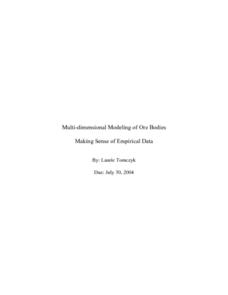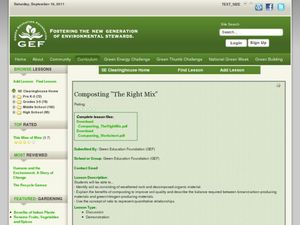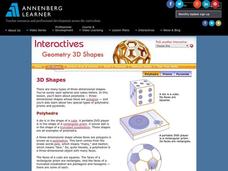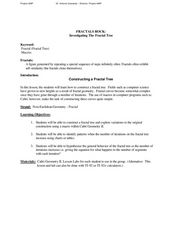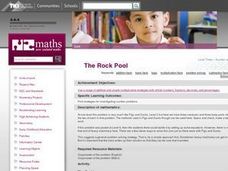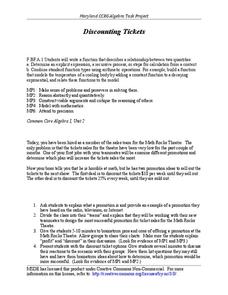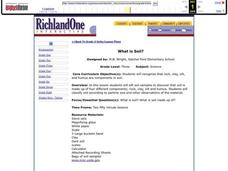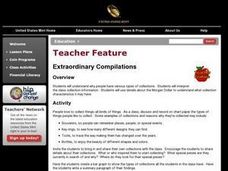Curated OER
Rock On!
Fourth graders make models of igneous, metamorphic, and sedimentary rocks out of different types of candy and cookies.
Curated OER
Rocks
Students use their five senses to experience different types of rocks. In groups, they compare and contrast the information they collected. They observe rocks in their local community and describe their uses to the class.
Curated OER
Multi-dimensional Modeling of Ore Bodies Making Sense of Empirical Data
Math scholars identify four different rock types in that strata and use this identification and data to construct a two dimensional geologic cross-section. They use data tables to construct a three-dimensional geologic cross-section.
Curated OER
Sampling Rocks
Students examine how to take a sample by looking at rocks in the schoolyard. In this sampling activity, students discuss ways to classify rocks by color, size, and weight. They think about how many rocks would make a good sample of...
Curated OER
Composting "The Right Mix"
Students investigate the correct mix of material types for compost. In this composting lesson, students explore the correct amounts of different types of materials to create a compost heap. Students then create a compost heap.
Annenberg Foundation
Geometry 3D Shapes: 3D Shapes
Explore vocabulary related to three-dimensional shapes. An instructional website describes the characteristics of different geometric solids. Learners can use an interactive component to view nets, faces, vertices, and edges of common...
Curated OER
Everybody Needs a Rock
Students, after making quantitative and qualitative observations of their rocks, construct a Venn diagram or dichotomous key to classify their rocks.
Curated OER
Time for All Ages
Fourth graders discover time keeping by analyzing technological advances in history. In this time lesson plan, 4th graders create and complete a KWL chart based on their research of a famous timekeeping invention, such as a...
Curated OER
Measuring Soil Temperatures at South Penquite Farm
Students investigate soil temperatures. In this graphing and earth science instructional activity, students insert temperature probes into different types of soil at varying depths. Students complete a data chart and construct a related...
Curated OER
Fractals Rock: Investing the Fractal Tree
Students investigate the relationship between fractals and sequences. In this geometry lesson, students build a fractal tree. They investigate different career fields where fractals are used in the real world.
Mathematics Vision Project
Module 6: Congruence, Construction, and Proof
Trace the links between a variety of math concepts in this far-reaching unit. Ideas that seem very different on the outset (like the distance formula and rigid transformations) come together in very natural and logical ways. This...
Indiana Science
How Many E’s?
Seventh graders explore random sampling by estimating the number of e's on the newspaper. They explain the possible error sources for this type of sampling, and compare the accuracy of sampling a small and large population. This is a...
Curated OER
Where Does Radon Come From?
Students discuss the differences between the three types of rocks and how radon can escape from the rocks themselves. They analyze other sources of radon in the environment. They work together to complete an activity and worksheet.
Curated OER
The Rock Pool
Third graders use number sense and appropriate problem solving techniques to solve the assigned problems. They write out the solutions to the assigned problems. They work in groups to solve the problem before reporting back to the whole...
Curated OER
Stem-and-Leaf Plots
In this stem-and-leaf plots worksheet, 9th graders solve and complete 9 various types of problems. First, they determine the mean, median, and mode of the stem-and-leaf plot shown. Then, students summarize the similarities and...
Howard County Schools
Discounting Tickets
A boss who can't do math? Oh, no! Young entrepreneurs use linear and exponential models to determine which discount will yield the most profit on ticket sales.
Curated OER
What is Soil?
Third graders examine what makes soil by creating a Venn Diagram. In this Earth environment activity, 3rd graders identify the different components that soil is made from. Students bring soil from their homes to examine and create...
Curated OER
Bias Sampling
Students demonstrate how the results of a poll or other scientific study can be biased by selecting special types of people to respond or by asking only certain questions.
Curated OER
Setting Up Equations
In this setting up equations worksheet, students solve 4 different problems that include setting up the equations in each problem. They write out an equation or set up an equations that describe each given situation. Then, students state...
Curated OER
Survey Says...
Students practice taking surveys to answer different questions about radio. In this communications lesson, students brainstorm to create questions they can ask strangers about how often they listen to their radio. Students...
Curated OER
Decomposing Artifacts
Seventh graders participate in an experiment in which they calculate the time of decomposition of different materials. In groups, they fill bags with different materials and cover them in soil. After six months, they create a line graph...
Curated OER
Extraordinary Compilations
Students discuss and record why people have various types of collections. They interpret the class collection of information then use details about the Morgan Dollar to understand what collection characteristics it may have.
Curated OER
Watch It Slide!
Students work together to examine inclined planes. They create a plan to raise rocks to build pyramids. They discover the changes that occur when the angle is increased or decreased.
Curated OER
Look At Those Leaves!
Learners observe and sort tree leaves. In this earth science lesson, students observe the attributes of real leaves and measure leaves using Unifix cubes.


